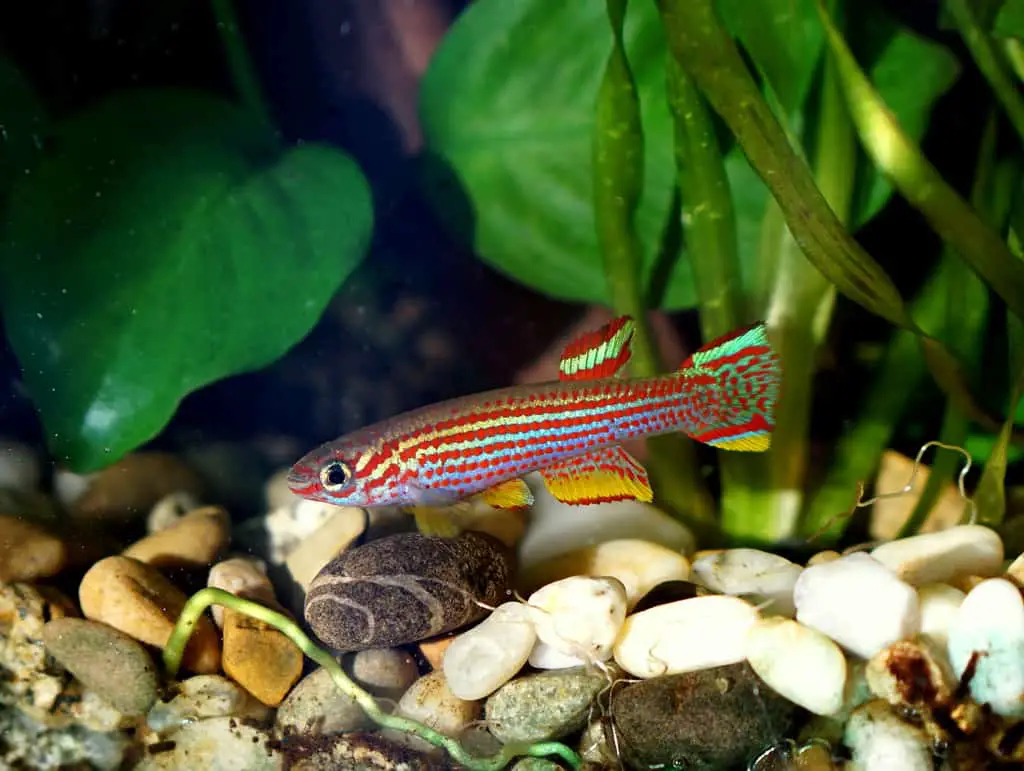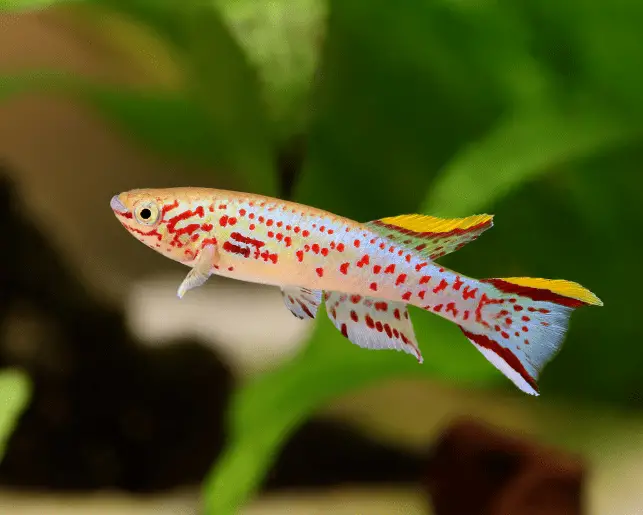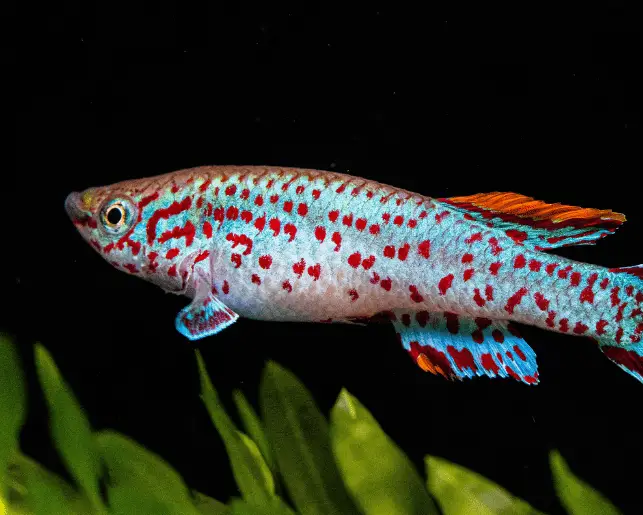Killifish are one of the more challenging choices for aquarium lovers. They are stunning to look at, but they can be a bit aggressive and some of them have a very short lifespan, which I will go into later on.
Regardless of your experience with these fish, it’s important to understand their behaviour to give them the best possible care. If you notice your killifish stays at the bottom of the tank, this could signify something that needs your attention.
Killifish can stay at the bottom of the tank due to swim bladder infections, ich, or if they are about to lay eggs. Staying at the bottom of the tank can also signify that your tank isn’t the best environment for your fish, and you may need to perform a water change or adjust the temperature.
The rest of this article will tell you everything you need to know about bottom-dwelling killifish, so you can better understand what this behaviour means and how to address the different problems it can signify. Read on to learn more.

Why Is My Killifish Staying at the Bottom of the Tank?
Here are some potential reasons why your killifish is staying at the bottom of the tank:
- Your fish has a swim bladder infection. Fish have an organ called a swim bladder that controls their buoyancy and ability to swim properly. Unfortunately, swim bladder infections are common. If your fish is swimming strangely, upside down, or unable to swim to the top of the tank, they might be suffering from an infection.
- Your killifish is suffering from ich or another illness. If your killifish is frequenting the lower section of its tank, this can mean that your fish is sick and needs treatment as soon as possible.
- The tank needs to be cleaned. A dirty tank can make your fish sick. This is why it’s important to make frequent water changes. Killifish are one of the more hardy breeds so your tank would have to be filthy to be a risk to them.
- Temperature adjustments may need to be made. If your fish is too hot or too cold, it might spend less time being active and more time near the bottom. Killifish do tend to prefer water on the cooler end of the scale.
- An aggressive tank-mate has injured your fish. An injured fish might not be able to swim regularly.
- Your killifish is carrying eggs. Killifish can spend more time near the bottom of the tank if they are carrying eggs.
- Your killifish is dying. Some species of killifish are known as annual killifish. They are native to very small bodies of water on Africa which dry up every year, leading to them dying. Annual killifish tend to only last approx 8-10 months.
Do Pregnant Killifish Stay at the Bottom of the Tank?
Pregnant killifish do tend to stay at the bottom of the tank. If your killifish is spending a lot of time laying at the bottom of the tank or swimming very close to the substrate, this can signify they are about to spawn. However, you should also check for other pregnancy symptoms to rule out illness.
It is also worth noting that if your killifish is about to spawn, they will still be fairly active around the bottom of the tank. If they are staying very still, that can be a warning sign of another problem, like the ones I have mentioned previously.
But how exactly can you tell if your killifish is pregnant or not?
How To Tell if Your Killifish Is Pregnant.
If you think that your killifish may be pregnant, here are some common pregnancy symptoms you should look out for:
- Your killifish is spending more time near the bottom of the tank. Not every killifish is the same, but many display this behaviour just before they are about to spawn.
- Your killifish is visibly more prominent than normal. Obesity in fish isn’t exactly a common thing. If you notice that your molly’s stomach appears to be bigger than usual, this can be a sign that your molly is carrying babies.
- Pregnant killifish may hide more. If you have good hiding places in your tank (as you should), a pregnant killifish will usually want to keep a distance between herself and the other fish around her. She can lay her eggs over the course of three to four days.
- Your killifish is female. While this may seem obvious, you must know whether or not your fish is female before making any judgments about pregnancy. This is crucial because if your killifish is a male, it’s likely that your fish is ill rather than pregnant. This can also signify the need for water adjustments.
This YouTube video does an excellent job of telling you all you need to know about killifish.
Are Killifish Bottom Dwellers?
Killifish aren’t bottom dwellers. While they’re known to have the occasional algae snack, they’re not naturally bottom feeders and should be swimming around the entirety of the tank. Bottom-dwelling fish include loaches, corydoras, plecos (plecostomus), and others.
If your killifish is spending a lot of time at the bottom of the tank, this is considered abnormal behaviour.

Signs of Illness To Look Out For.
Unfortunately, a bottom-dwelling killifish might be a sick one.
As previously discussed, killifish aren’t natural bottom-dwellers like loaches and other common bottom-feeder species. If you’re convinced that your fish isn’t pregnant, it’s essential to check for symptoms of common fish illnesses.
Here are some illnesses and ailments you should check for:
- Ich: Ich is one of the most common illnesses seen in freshwater fish. It’s a parasitic infection that causes white spots to appear on your fish.
- Swim bladder infections: An infected swim bladder can affect your pet’s ability to swim properly.
- Fin rot: Fin rot is relatively easy to diagnose. While this is more common in bettas and other fish with more elegant tails, killifish can still be prone to this.
- Poisoning (contaminated water): Unfortunately, it’s all too easy to contaminate the water in your fish tank accidentally. If you use harsh soaps to clean your fish care supplies, the chemicals in the soap can transfer over to your tank. You should also have a designated bucket for water changes to protect your fish from cleaning solutions.
- Chlorine sickness: It’s imperative to ensure that the water in your fish tank is dechlorinated. If you forget this step during cleaning and/or water changes, this can make your fish very sick.
In addition to bottom-dwelling behaviour, here are some signs of illness that you should look out for:
- Slowed movements
- Rotted fins
- Your fish isn’t eating
- Increased or decreased aggression (depending on the typical behaviour of the individual fish)
- Significant change in colour, usually turning visibly paler.
How To Treat Common Killifish Illnesses.
If you think your fish is suffering from an illness, it’s crucial to treat your tank properly. One easy fix is, surprisingly, garlic. Garlic has strong antiparasitic properties for both humans and animals, so it works really well for treating ich. By placing a small piece of garlic in your fish tank, you can quickly rid it of ich and keep your fish healthy.
Garlic is also antibacterial and antifungal, which means that it can help soothe the symptoms of fin rot as well.
Do Killifish Like To Hide?
Killifish like to hide, like most fish. Hiding places allow your fish to feel safe while getting accustomed to a new tank. They can also serve as shelter, just in case some of the other tank members show aggression.
A problem with an aggressive or bullying tankmate could be a reason why your killifish is staying at the bottom of the tank, although, to be fair, killifish can hold their own against similar sized tankmates. They could be stressed out by any aggression so wants to hide away. If you have other killifish in your tank, their may be a dispute over the pecking order. Killifish tend to be sold in pairs rather than larger groups for this reason.
If your fish stays close to the bottom to hide, this is probably nothing to worry about. It’s still a good idea to double-check for symptoms of pregnancy and illness for safety.

Conclusion.
Killifish, especially annual killifish can be quite challenging for a beginner, but they are a hardy breed. However, no fish is immune to ailments. If your fish is spending a lot of time near the substrate, this could mean illness, pregnancy, or an inadequate environment.
Hopefully, this article has helped you better understand your killifish, so you can analyse their behaviour and continue to keep your fish as happy and healthy as possible.

